Matador Network's Blog, page 1190
January 3, 2019
New Year’s resolutions Philadelphia
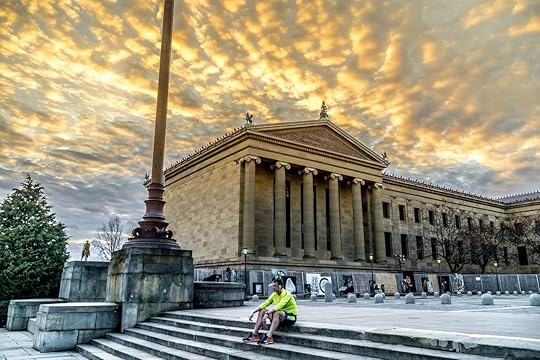
Every year, we Philadelphians reflect on the improvements we want to make in our lives, just after we get home from Two Street on New Year’s Day. And, every year, although we really want to commit to bringing better versions of ourselves to Philly’s future, we have trouble staying on track — there are resolutions Philadelphians can never keep. Here are seven of them.
1. Keep a shoveled-out parking spot.
We all want to be better neighbors and have peace and harmony on our block, but when someone takes a parking spot that they didn’t shovel, we go right back to having a parking cone and a chair waiting by the door just in case.
2. Protect ourselves in the face of perpetual heartbreak.
Falling in love and putting your soul into something is an exercise in trust and vulnerability. But once your heart has been broken, it can be hard to find your way back. Here’s looking at you, Philadelphia sports teams. Perhaps it’s time to say goodbye and focus our energy on something more positive…just as soon as we get next year’s season tickets.
3. Know when to say no to the Citywide Special.
We all love a good deal, that’s why the allure of the Citywide Special is hard to pass up. But this year, we’ll try to have only one Citywide at a time. Or maybe just two, tops.
4. Run the Philadelphia Museum of Art steps at least once a week.
Rocky was onto something with his art museum workout. It’s killer cardio that’s actually fun and provides great views. But as much as we like to think it’s going to happen this year, we’re not holding our breath.
5. No more grocery shopping at Wawa.
We all feel slightly sluggish after overindulging over the holidays. Time to restock the fridge with nutritious food and get back to healthy eating. That means meal planning, sticking to your grocery list, and not getting derailed by the convenience of Wawa. That said, a breakfast sandwich is nothing more than a lean, mean, protein-delivering machine.
6. Be a kinder, gentler version of ourselves.
Spreading love and kindness costs nothing, and it makes us all feel better. And we’ll all be doing that as soon as that jerk in the Cowboys jersey gets out of our line of vision.
7. Adopt cautious optimism as our new worldview.
We understand that, now that we have a Lombardi, we can’t win one every single year…but to hell with caution — this year is ours, too! 

More like this: 13 things you’ll get addicted to living in Philadelphia
The post 7 New Year’s resolutions Philadelphians make but never keep appeared first on Matador Network.

Eating guinea pig in Peru

The bright red and green signboard on the cobblestone sidewalk in front of La Casita de Victoria read ”cuy al palo”. My Spanish may be rudimentary, but the object speared on a wooden stick and suspended over an open fire looked like a plump, toothy rat with no tail. At this roadside food stand and many others like it in rural Peru, the house specialty is roasted guinea pig to go.
It’s estimated that indigenous people in the Andes Mountains have been eating domesticated cuy (pronounced “kwee”) since 5000 BC. It’s such a part of the culture that a 1753 painting of the last supper in Cusco’s Cathedral Basilica shows Jesus and his disciples with cuy as the main course. Peru even has a cuy holiday, Día Nacional del Cuy, that’s celebrated on the second Friday of October with festivals and fairs across the country. Rural villages have always had cuy on the menu, but it’s increasingly common in major cities — and even in the US. The rise in popularity has been good for farmers as the average farmer makes around $30 a month in Peru whereas guinea pig farmers can make as much as $130, according to the BBC.
But if you grew up in the US like me, chances are you’ve only encountered these furry critters as a pocket pet.
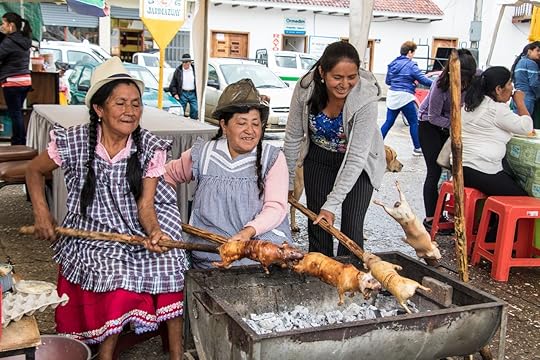
Photo: MindStorm/Shutterstock
At La Casita de Victoria, I walked toward the adobe clay oven for a closer look at the creature on the spit. A woman deftly rotated the stick a quarter turn, and the animal’s skin began to bubble and brown. As the wood smoke wafted upwards, our guide explained how cuy al palo is traditionally prepared: First, the guinea pig is rubbed with salt and garlic for added flavor, then it’s skewered and roasted whole — teeth, claws, ears, and all. It can be an unsettling sight for first-time visitors.
There are plenty of practical reasons why cuy has remained a dietary staple over all these centuries. The animals are high in protein and they’re easy to raise — all you need is a small pen and a steady supply of vegetable scraps for food. I visited a Quechua household in nearby Chinchero and saw a pen full of guinea pigs happily munching away on lettuce underneath — irony of ironies — the very stove where they would be cooked.
Despite their name, guinea pigs are neither pigs nor from the West African nation of Guinea. The rodent species is native to the Andean highlands of Peru, Bolivia, Ecuador, and Colombia. The Inca ate cuy for ceremonial meals and religious festivals, and folk doctors used the mammals in traditional healing rituals to diagnose diseases. It’s also clear that the animal played an important role in society. Archaeologists in Peru and Ecuador have unearthed statues of guinea pigs that date back to 500 BC.
I tried to keep this rich history in mind as I watched the woman lift the crispy cuy from the fire pit. After a few swift chops with a knife, she wrapped the segmented meat in a piece of plain brown paper, popped it into a paper bag with a fistful of napkins, and wished us buen provecho, or “enjoy your meal.”

Photo: Christian Vinces/Shutterstock
As we drove away from the cuyería, our guide explained that roasting is just one way Peruvians prepare guinea pig. Another popular local dish is cuy chactado where the meat is flattened and then deep-fried. Some of Lima’s top chefs are preparing cuy dishes without the feet and head attached. At roadside stops, however, cuy roasted on a stick is the most common.
A tantalizing aroma filled the vehicle as we unwrapped the paper packaging. There’s only one way to eat cuy al palo, and that’s with your hands. It’s a bit messy, but that’s what the napkins are for.
I picked up a hind leg and tried to ignore the little claws attached to one end. I bit into it and pulled off a piece of meat. It tastes kind of like a cross between rabbit and turkey. The meat is tougher and gamier than chicken, and it’s surprisingly tasty.
A few days later, I found myself in the middle of a street fair in Cusco. As I wandered among the food vendors, I spied a couple of familiar blackened shapes propped up against a whole roasted chicken and stack of round yellow cornbreads.
“Cuy al palo,” I thought to myself, and this time my mind translated it to “delicious.” 

More like this: Chile’s whole-lamb, open-fire asados put your local barbecues to shame
The post What it’s like to eat guinea pig in Peru for the first time appeared first on Matador Network.

January 2, 2019
Tips for visiting Versailles

Versailles is an immense art piece. Everything currently on the 2,000-acre estate was thought out, designed, and built meticulously over 100 years (1683-1785) to become the outstanding place it is today. And although every single nook and cranny of the estate, from the furniture in the palace to the groves and paths in the gardens, is worth seeing, you probably only have a limited amount of time in your hands. That’s why we’ve asked French art historian and architecture expert Dorian Dallongeville to give us the lowdown on how to make the best out of your day in Versailles.
Dorian Dallongeville started studying Art History in high school when he was 16 years old. He made the discipline his major at the University of Nantes, France, for one year and then attended the Ecole du Louvre for four years where he graduated in 2009. Dallongeville’s area of expertise is architecture between the end of the Middle Ages (1492) and the French Revolution (1789). Dallongeville was the senior curator at French Lines for eight years. He’s currently training to become a civil servant.
Before you go: the #1 piece of advice for visiting Versailles
The best times to visit Versailles
How to get to Versailles
Guided tours
How to organize your visit
Most underrated spot to check out
If you have more time
Before you go: the #1 piece of advice for visiting Versailles

Photo: Mistervlad/Shutterstock
The estate is huge, the crowds are massive, and security is very high, all of which translates into very long lines at the entrance, so you need to come to Versailles prepared.
Buy a “passport with timed entry” online before your visit. Dallongeville explains that if you don’t you will spend hours in line outside to get in.
The “passport with timed entry” will give you access to the whole estate (which is exactly what you want) and guarantees entry within half an hour of the selected time. We recommend that you splurge a little and choose the option that includes the amazing Musical Fountain Shows and the Musical Gardens — just make sure they are happening on the day of your visit before you purchase your ticket
This ticket also includes an audio guide, but we strongly suggest that you download the free app on your phone or tablet before your visit instead of waiting at the audio guide desk. It includes the audio guide tour of the palace and an interactive map of the estate. It can be used without an internet connection.
The best times to visit Versailles

Photo: ThomasLENNE/Shutterstock
Versailles is gorgeous all year round, but because the gardens are just as important and beautiful as the palace, we suggest you visit in June when the blossoms are out, the big events are on, and the crowds are still manageable. (July and August are the busiest months of the year.)
Visiting in winter can be magical, especially if there is snow, but you’d be missing out on the spots that make Versailles the amazing estate that it is, i.e. many of the sculptures in the gardens may be covered, the Orangery will be closed, etc.
Plan to spend the entire day visiting the estate, so come before opening time (9:00 AM) and leave at closing time (5:30 PM) — you won’t regret it.
To maximize your time in Versailles, visit the estate during the day and take part in one of the events organized in the evenings. Check out the program of the events and schedule your visit accordingly. There are incredible concerts, operas, plays, ballets, art exhibits, masked balls, fireworks displays, and more that take place within the palace or the gardens — not your run-of-the-mill venue. Dallongeville insists that the icing on the cake after a visit to the estate is attending one of the night fountain shows. They are mind-blowingly beautiful, but they only take place every Saturday and Sunday in the summer months, so plan ahead.
How to get to Versailles
Versailles is a town outside of the city of Paris. It’s a quick one-hour train ride, but be organized and arrive at the entrance before opening time with your “passport with timed entry” all ready to be presented to the staff.
There are three train stations in the town of Versailles. Hop in the RER C train in Paris to arrive at the train station Versailles Rive Gauche, which is the closest to the estate (10 minutes on foot). It is the last train station on the line, so you’re sure to not miss your stop.
Guided tours
The estate is huge and filled with amazing stuff to check out. Dallongeville suggests that you don’t book a guided tour and use the audio guide and map available on the free Palace of Versailles mobile app to visit the at your own pace, so you’re not stuck inside on a visit of the King’s State Apartments (which are stunning, by the way) when you just want to be enjoying the break in the weather to roam the beautiful gardens.
How to organize your visit
Refer to the map of the estate to plan your visit.

Main facade of the Palace and Marble Courtyard – Photo: Jacky D/Shutterstock
All visitors arrive to Versailles through the main entrance gate (Grille d’Honneur) and walk across the Courtyard of Honour to reach the ticketing desks and security check. Once done with the entry requirements, don’t rush inside the palace. Instead, take the time to walk the Royal Courtyard, followed by the Marble Courtyard, and admire the facade of the palace — it’s pretty swanky.

The Hall of Mirrors – Photo: Mister_Knight/Shutterstock
Dallongeville highly recommends that visitors start with the palace where the royal families of Louis XIV, XV, and XVI lived from 1682 to the French Revolution. It is less crowded inside at 9:00 AM than it is at 11:00 AM, so get cracking with the lavishly decorated and furnished Private Apartments, including the underrated but gorgeous Mistresses’ Apartments (that’s right) and Louis XV’s daughters’ Apartments. The Royal Chapel, Royal Opera House, State Apartments, and Hall of Mirrors are also not to be missed. Finish off your morning with the Gallery of the Great Battles, which is sumptuous. This visit should take between 90 minutes and two hours. When you’re done, head outside to the gardens.

View upon leaving the palace to access the gardens – Photo: Takashi Images/Shutterstock
Once outside, don’t get sucked into the magnificent perspective — going straight down the steps to the Latona fountain and parterre and down the green carpet towards the Grand Canal is a rookie mistake. Instead, spend a couple of hours exploring the many secretive gardens and groves on the left and right of that perspective — that’s where the good hiding spots and the cool sculptures are located. The parterre of the Orangery is also well worth spending some time in to see orange trees, lemon trees, oleander, palm and pomegranate trees spread outside in the French formal garden in summer.

The Orangery parterre – Photo: PhotoFires/Shutterstock
There are places to grab a snack, a cup of coffee, and a drink throughout the estate, and there are three restaurants where you can sit and have a restful lunch. If the weather’s good, grab something to go and sit outside to admire the gardens — picnic spots don’t get much fancier than that.
Visiting Versailles involves a lot of walking, so if you want to give your feet a little break and if time allows it, rent a rowing boat for 30 minutes and take a little paddle on the Grand Canal. It’s always a hit with the kiddos, and on a sunny day, it’s a lovely activity to see the estate from a different point of view.
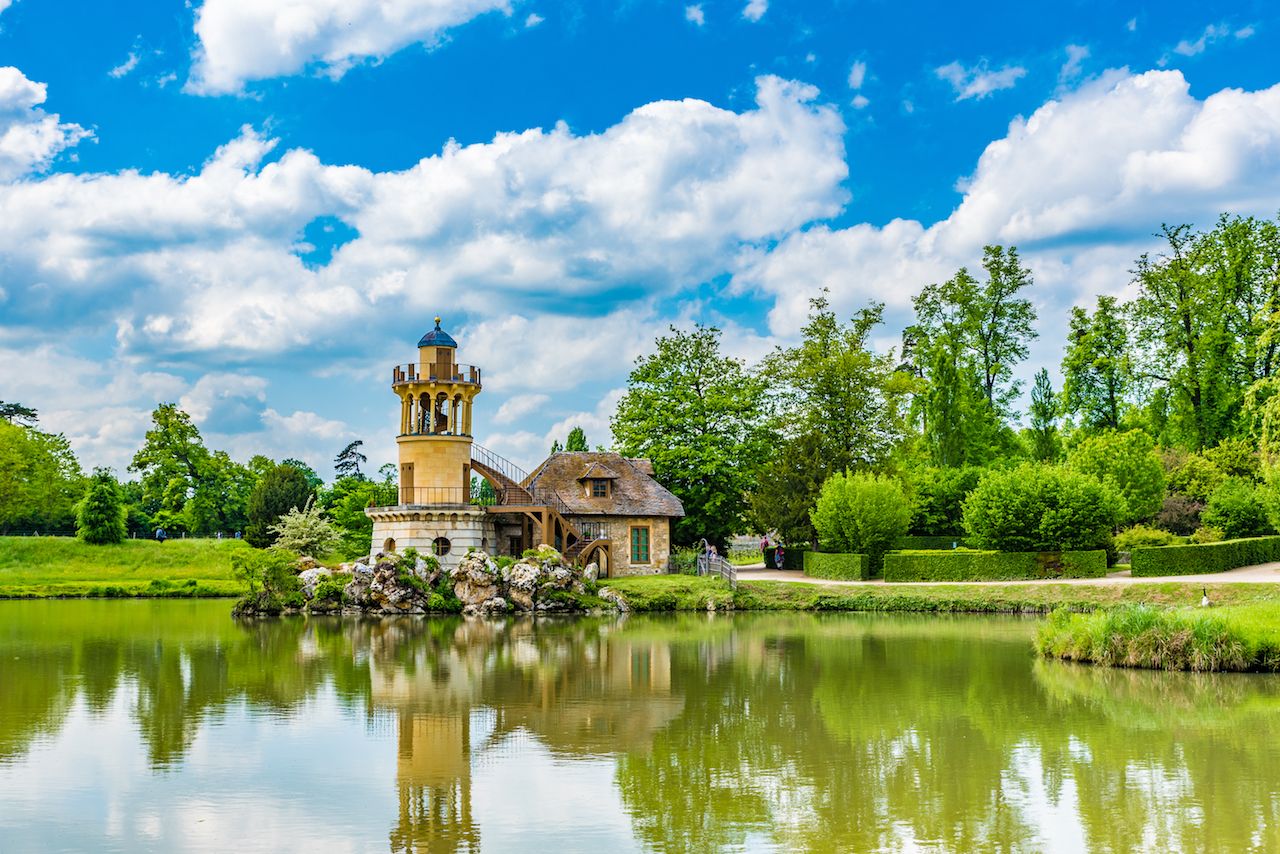
The Queen’s hamlet – Photo: Takashi Images/Shutterstock
Once you have a little food in your belly and have a taken a break from walking, head to Marie-Antoinette’s estate to visit the recently restored Petit Trianon and the Queen’s Hamlet — fans of Sofia Coppola’s Marie Antoinette will love checking this area. Dallongeville recommends that you take the time to wander around this bucolic and serene part of the park, which transports you well away from the city.

The Gallery of Coaches – Photo: Chateau de Versailles
You should still have about one hour before closing time (5:30 PM), so head back to the Courtyard of Honour and through the main gate where you started and visit the Gallery of Coaches in the Great Stables. There, you’ll see the most amazing collection of travel vehicles, from coaches and small carriages for Marie Antoinette’s children to sedan chairs and sleds, all adorned with carvings, golden embroideries, golden decorations, etc.
Most underrated spot to check out

Photo: Alfredo Garcia Saz/Shutterstock
The Grand Trianon, although not mentioned in our one-day visit of Versailles above, is worth checking if you have time to spare. People flock to the Petit Trianon, so the Grand Trianon is much less crowded yet as magnificent.
The Peristyle, a sheltered colonnade connecting the two wings of the Grand Trianon, is surrounded by gardens and is the highlight of the Grand Trianon. Plan your visit to be there at sunset when the light hits the beautiful pink marble columns — it’s a spectacle like no other.
In 1963, General de Gaulle restored the Grand Trianon to use it to host visiting foreign dignitaries. It’s not the case since 2009, but stately events are still hosted for foreign officials.
If you have more time
The city of Versailles, like the estate it was built around, is superb. Dallongeville suggests that you spend two days exploring it if you have time. Spend the first day in the estate and the second one visiting the following spots:
The King’s Vegetable Garden

Photo: Versailles Tourisme
When Louis XIV built Versailles, he hired an architect for the palace (Le Vau), a landscaper for the park (Le Notre), an artist for the sculptures (Le Brun), and a vegetable and fruit specialist for the kitchen garden (La Quintinie) to grow and provide the King and his court rare and out-of-season fruits and vegetables.
The 22-acre vegetable garden built between 1678 and 1683 still exists in its original location, a few minutes’ walk from the palace, and still produces veggies and fruit for sale in the shop. It is also the location of a prestigious gardening and landscaping school. To visit this unique spot that is as much part of Versailles’ history as the estate, check out the hours of operation here.
The Royal Tennis Court

Photo: Chateau de Versailles
The jeu de paume is an old version of tennis and was a popular sport in the 17th century among the royal family and the court. The Royal Tennis Court, built a few hundred meters away from the palace in 1686, played a significant role in the French Revolution as it was the place where actors of the demand for democracy gathered. The Royal Tennis Court still stands today and can be visited. Check out the hours of operation here. 

More like this: How to crush the Louvre in one day
The post How to make the most of a one-day visit to Versailles appeared first on Matador Network.

Ultramarathons in South Africa
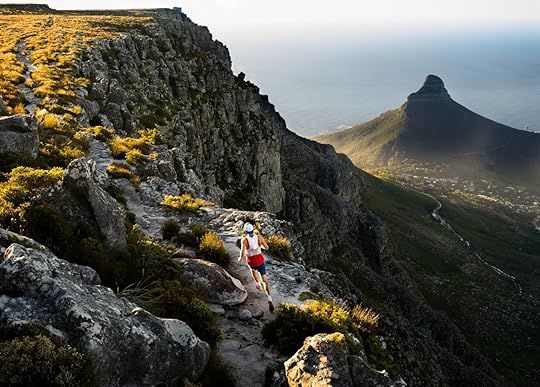
It’s the start of the year and time for new resolutions. If completing trail running in your hometown seems like kids’ stuff, consider an ultramarathon overseas. South Africa hosts several ultramarathons that may just be the highlight of your year.
South African races like the Comrades Marathon and Two Oceans Ultra Marathon are well-known globally, but the list of ultra-races is growing, as is the community of runners gearing up to take them on. Here’s everything you need to know about ultrarunning and the South African ultras you need to add to your race calendar this year.
Ultras and their appeal

Photo: Maridav/Shutterstock
An ultramarathon — commonly referred to as an ultra — is any race longer than the traditional marathon distance of 42.2 kilometers (26.2 miles). They’re long, often brutal, and certainly not for everybody. But a growing community of runners is signing up for these races — all drawn by the allure of completing an ultra.
Showcased in films like The Barkley Marathon: The Race That Eats Its Young, there’s a romanticism to ultrarunning, with those who take it on displaying the grit we all want to find in ourselves. To complete an ultra, you need to dig deep, fight off the urge to quit when your body is falling apart, and be willing to go to some pretty dark places before finally crossing the finish line.
It can be an awful experience that has you questioning why you entered in the first place, but when you cross the finish line, all that darkness is washed away by a wave of euphoria. I like to call it “finish line amnesia,” and it’s the reason ultra-runners continue to line up at the starting line despite often swearing mid-race to never to do so again. Once that bug has bitten, it’s a hard thing to shake.
From the lush coastal stretches of the Wild Coast in the Eastern Cape to the imposing, raw beauty of the Drakensberg Mountains, these are the races that’ll make you book a ticket to South Africa.
Hobbit Journey — April
View this post on InstagramA post shared by Bry Mccormick (@bry_bry_za) on Apr 29, 2017 at 11:57pm PDT
Limited to just 30 runners, the Hobbit Journey is an arduous yet rewarding 56-mile run across the notorious Amthole Hiking Trail in the Eastern Cape. Starting and finishing at the Arminel Hotel in Hogsback, the event is broken up across two days, traversing towering forests, rivers, and technical terrain. Runners are self-supported and aid stations are limited, meaning you need to ensure you can carry the bulk of your supplies throughout the route. Shorter 23.6-mile, 10-mile, and three-mile runs are offered for those not ready to take on the big one.
Two Oceans Ultra — April

Photo: Old Mutual Two Oceans Marathon/Facebook
Billed as “the world’s most beautiful marathon,” the Two Oceans Ultra Marathon is a 35-mile course that runs through the unparalleled beauty of the Cape Peninsula. The first 17 miles are flat and fast, but don’t be fooled by the gentle introduction because the climbing starts as you approach the iconic Chapman’s Peak, and your legs are in for more punishment with the highest point of the race — Constantia Nek — still lying ahead.
Thankfully, the view along this stretch is jaw-dropping, with the Atlantic Ocean to your left and the rugged outcrops of the mountain to your right. Once you have made your way up and over Constantia Nek, you’re virtually home free with Rhodes Drives, a gorgeously forested stretch of road, relatively light in terms of gradient, before you’re hit with a tricky little uphill towards the finish at the University of Cape Town. The last few kilometers make for a festive occasion with thousands turning out annually to cheer runners through the home stretch and UCT’s Green Mile.
Ultra-Trail Drakensberg — April

Photo: Ultra-Trail Drakensberg – UTD/Facebook
A 100-mile run through the Drakensberg Mountains, with 18,000 feet of climbing, this is a beast of a run. But for those willing to take it on, the payoffs of the Ultra-Trail are plentiful. The course cuts through the Maloti Drakensberg, a World Heritage site. While it is undeniably beautiful, the route is also harsh and unrelenting, with runners often isolated for long periods of time. Traversing iconic stretches of mountain, such as the Sani Pass, Khanti Ridge, and Hodgson’s Peak, participants experience some of the best mountain trails on offer — but they will need to find some deep reserves to cross the finish line, with the slowest runners routinely spending two days out on the route.
Comrades — May/June

Photo: lcswart/Shutterstock
The grand-daddy of all South African ultras and arguably the most famous run in South Africa, the Comrades is the litmus test for local runners and a bucket-list event of note. The route runs between Durban and Pietermaritzburg, and the race switches direction each year with the “up” run (54 miles) starting from Durban and the “down” run (56 miles) heading out from Pietermaritzburg. Qualification for the event is a four-hour-50-minute marathon, with the field capped at 25,000 runners and five cut-off markers set throughout the race.
This is a race that captures the heart of a nation with the final cut-off time of 11 hours watched with bated breath across the country. Few races garner the kind of attention that the Comrades Marathon commands, and that’s unlikely to change any time soon. While registration is full for this year, it’s a race worth seeing as a spectator.
Namibia Crossing — June
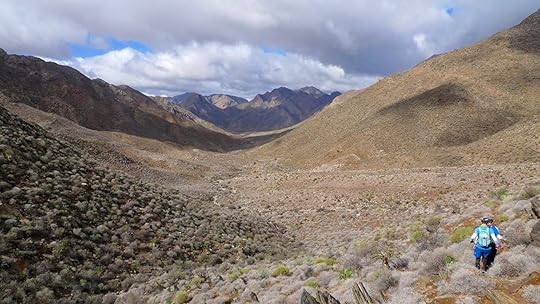
Photo: Wildrun/Melvyn Quan/Facebook
Lasting five days and covering 200 kilometers (124 miles) two countries, The Namibia Crossing begins in South Africa and crosses over into the /Ai/Ais-Richtersveld Transfrontier Park in Namibia. Running conditions here are like nowhere else on Earth, with participants passing through the crystal fields of Sendelingsdrif in South Africa and the infamous giant boulders of Tatasberg deep in the /Ai/Ais-Richtersveld Transfrontier Park, before crossing the Orange River into Namibia and cutting through the wild lands of the Fish River Canyon. At times you will feel like you are on another planet, with the stark, rocky terrain resembling a moonscape, not the earthly realm. It is a magic experience and one that all runners need to undertake.
Washie 100 — July
View this post on InstagramA post shared by DHS Old boys A.C. (@dhsoldboys) on Jul 26, 2018 at 9:28pm PDT
The Washie 100, run from Port Alfred to East London in the Eastern Cape of South Africa, is the only 100-mile road race in South Africa. While the Comrades Marathon may be considered the more iconic of the two, in terms of sheer toughness, the Washie has it beat. The Washie is not televised, which is why most people outside of the running community do not know about it, and there is no official support, meaning runners need to provide their own. No water points, no massages, no medical tent. Nothing. If you want support, you need to provide your own. That probably explains why in 2018 only 153 runners lined up for the Washie 100 compared to the more than 16,000 who waited for the starter’s gun to go off at Comrades the same year.
Wildcoast Wildrun — August/September
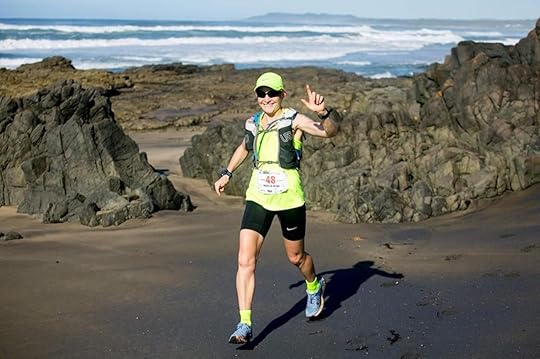
Photo: Wildrun/Facebook
The Wildcoast Wildrun is not an ultra in the truest sense of the word but easily one of the most visually — and emotionally — rewarding runs on the South African racing calendar. Run over three days along the ruggedly beautiful Wild Coast in the Eastern Cape, the Wildcoast Wildrun is broken down into a 27-mile and two 21-mile traverses, cutting through the rural homelands of the isiXhosa people of South Africa. It is a tough race with big climbs and long, isolated stretches of beach, with sometimes brutally soft sand. You can go for hours without seeing another person, but while it tests the body, it rewards the soul as runners make their way through some of the last, truly untamed stretches of the Eastern Cape.
Karloof 100 — September
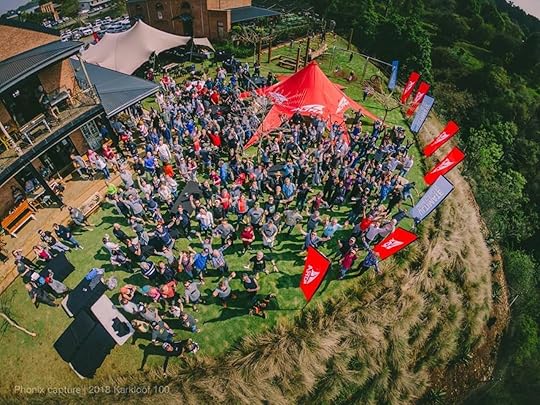
Photo: Karkloof100/Facebook
One of a select few 100-mile races in South Africa, and the first in Kwa-Zulu Natal, the Karloof 100 runs through the dense indigenous forests, wetlands, and grasslands of the Karloof region. Modeled on international 100-milers, the Karloof 100 is an out-and-back course with aid stations located every 10 miles, and it also acts as a qualifier for the Western States Ultra in North America.
Otter Trail Run — October

Photo: Otter African Trail Run/Facebook
Heralded as the “Grail of Trail,” the Otter Trail Run is a 26-mile trail race run between Storms River and Nature’s Valley in the Western Cape of South Africa. Usually completed as a hike across five days, the run is tough and technical with four river crossings, including a tricky navigation of the Bloukrans River. Depending on what time you end up crossing, the Bloukrans could be more of a swim than a run.
Although grueling, it is also gorgeous, with jaw-dropping views, pristine white beaches, and a coastline that seems to run forever. The Otter acts as the finale for the Golden Trail Series, a global trail running series contested throughout the year, and draws some of the world’s best runners. That means entries are extremely hard to come by, with the race selling out every year. Get yourself a priority listing and cross your fingers because even that won’t guarantee entry.
Skyrun — November

Photo: K-Way SkyRun/Facebook
One of the country’s most revered Ultras, the Skyrun offers a 40-mile and 62-mile route, with the latter acting as a qualifier for the Western States. This is true mountain running, crossing a variety of terrain, ranging from rocky, rugged outcrops to sections of jeep track. The area is abundant with life, with more than 650 plant and 80 animal species found here. Starting out from the town of Lady Grey, runners quickly find themselves spread out across the route with little in the way of civilization until they cross the finish line. Participants need to be completely self-sufficient and able to navigate their own way with no markers on the route — making the Skyrun one of the most challenging races of its kind.
Ultra-Trail Cape Town — December
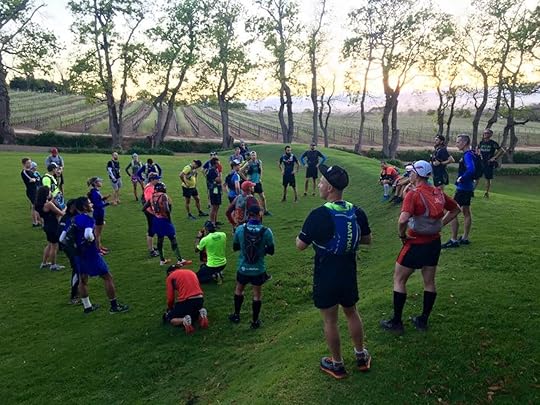
Photo: Wilhelm Vogts/Ultra-trail Cape Town – UTCT/Facebook
Not many events can boast a New7Wonders of Nature as their centerpiece, but the Ultra-Trail Cape Town — with the iconic Table Mountain Nature Reserve forming a large part of the route — can do exactly that. This relatively new event has just celebrated its fourth anniversary and has quickly solidified itself as a global fixture. It forms part of the Ultra-Trail World Tour and covers some of Cape Town’s most recognizable landmarks, including the Constantia Winelands and the upper slopes of the Kirstenbosch Nature Reserve. There are also 40-mile, 22-mile, and 13-mile routes for those less inclined to take on the mammoth 100 kilometers (62 miles), but all are demanding with plenty of climbing and technical challenges thrown at you throughout. 

More like this: Outdoor runs in 2019 you should sign up for now
The post Want a real resolution? Go ultrarunning in South Africa this year appeared first on Matador Network.

Where to find street art in Kiev

Kiev’s fame as an Eastern European cultural hotspot has increased dramatically since 2014 when a number of large murals began appearing on the facades of old Soviet buildings. Today, Ukraine‘s capital city hosts over 150 pieces of public art produced by local and international artists, often hidden in lesser-known parts of the city. The bold, massive paintings in the neighborhoods east and west of the Dnieper are reshaping the city’s identity.
Kiev, a millennia-old metropolis with a long history of conflict, is quickly becoming a vibrant hub for creatives by establishing itself as a central node on the global street art scene. Exploring Kiev through its murals is a highly rewarding treasure hunt, and by going out in search of the colorful compositions that decorate the urban landscape, you will also find yourself discovering historical landmarks, amazing architectural pieces, and underrated areas you would otherwise never visit.
Note that “Kiev” is the Russian-language name of the city, whereas “Kyiv” is the Ukrainian-language name. Here we use the traditional and most commonly used spelling.
1. Lake Mural by Anastasia Belous

Photo: Angelo Zinna
Location: Kostiantynivska Street 56
London-based Ukrainian artist Anastasia Belous painted this striking mural as part of the ArtUnitedUs project in 2016. The image is located steps away from the Tarasa Shevchenka metro station and the Museum of Modern Art of Ukraine in the Podil district. It shows a woman floating in a pond with her head above water, surrounded by water lilies and koi carps. Although the artist used bright, vibrant colors, the picture conveys a sense of calm in the midst of the busy city streets.
2. Untitled by Nunca

Photo: Angelo Zinna
Location: Spaska Street 6а
You will just need to walk a few steps from the Kontraktova Ploshchad metro station to see this mural by Brazilian street artist Francisco Rodrigues da Silva, AKA Nunca, peeking out over the busy streets of Podil. In an attempt to unite Brazilian and Ukrainian cultures, Nunca painted a 50-foot-high Cossack man as he is being adorned with traditional Brazilian painting. The creation of this mural sparked a controversy among the residents of the neighborhood, who opposed the painting of the image to protect the century-old building’s historical relevance.
3. Renaissance by Seth & Kislow
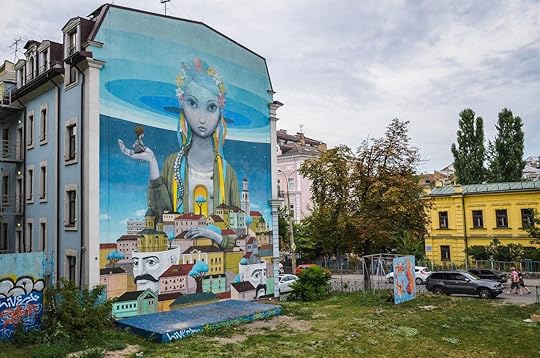
Photo: Angelo Zinna
Location: Borychiv Tik Street 33/6
This giant mural covering the wall of a five-story building near St. Andrews Church and the Bulgakov Museum represent the rebirth of Ukraine after the 2014 revolution. Painted by French artist Seth Globepainter in collaboration with Alexei Kislow, the 50-meter-high artwork was created to celebrate the French Spring Festival on Andriyivskyy Descent (an ancient street) at the conclusion of the Euromaidan protest. The girl in the painting is adorned with a crown of flowers and is wearing the military jacket used by protestors in the Independence square riots. The figure represents the new spirit of Ukraine; the child she is holding symbolizes the restored hope for the future.
4. Portrait of Serhiy Nigoyan by Vhils

Photo: Angelo Zinna
Location: Mykhailivska Street 22
The portrait of Euromaidan activist Serhiy Nigoyan appeared near the famous Saint-Sophia Cathedral in the summer of 2015. Portuguese artist Alexandre Farto, also known as Vhils, depicted the Armenian-Ukrainian protester who was shot in 2014 during the Hrushevskoho Street riots. Nigoyan was the first activist who died in the anti-government demonstration and has, since then, become a symbol of the Ukranian revolution. This piece of work is unique in Kiev not only for the subject portrayed but also for Vhils’ trademark technique: Rather than painting the face, the artist carved it directly on the wall of a building using exposed bricks and falling plaster.
5. Crows by Alexandr Britcev
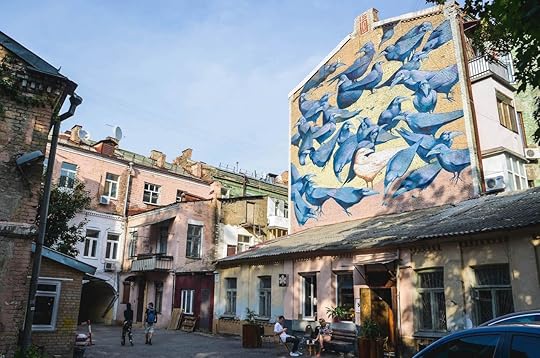
Photo: Angelo Zinna
Location: Reitarska Street 9
Of the many murals in Kiev, “Crows” by local artist Alexandr Britcev is one of the hardest to come across. Hidden inside an anonymous courtyard near the Golden Gate monument, you will find this brick wall covered entirely with dark blue crows surrounding a single white bird. The painting was completed at the end of 2015 and references the legendary aviary of Reitarskaya, where three crows named Cyril, Carlos, and Corbin are said to have been living for over 20 years.
6. River Crossing by Fintan Magee

Photo: Angelo Zinna
Location: Voloska Street 19/22
It’s at the intersection between Voloska and Khoryva streets in the hipster neighborhood of Podil that you’ll be able to admire Fintan Magee’s masterpiece, the painting of a huge deer helping a man to cross a river. The Australian artist volunteered to compose the image on the State Sanitary and Epidemiological Service of Ukraine to represent the period of transition the country was going through after the revolution and, at the same time, draw public attention on the current environmental issues. 

More like this: The 9 best street art cities in the world
The post Kiev is an amazing hub for street art — and these are the best murals in the city appeared first on Matador Network.

Wave-shaped apartment building

After the gorgeous swimming pool project for Copenhagen’s harbor, Danish architectural design strikes again with this amazing wave-shaped apartment complex — one of the most unique buildings in Europe.

Photo: Henning Larsen
Henning Larsen Architects, a Copenhagen-based architecture firm, has just completed The Wave — a waterfront apartment complex in Vejle, Denmark. The building consists of five rounded towers and covers nearly three and a half acres. The complex holds over one hundred luxury apartments, and also features a public pier with the aim of revitalizing the area’s waterfront. Each tower consists of nine identical floors, creating the appearance of a single unified building across all five “waves.”

Photo: Henning Larsen
Construction on The Wave started back in 2006, though work was halted due to the financial crisis, and did not resume until 2015. The complex was designed as an extension of its surrounding landscape — the hills, the waters of Vejle Fjord, and the rise of the fjord itself — and pays tribute to the town’s seafaring heritage. The project was finally completed in December 2018.

Photo: Henning Larsen
Even before the project was finished, it was garnering international recognition and receiving awards. In 2009, the first two completed towers were named the “Residential Building of the Year” by Byggeri, a Danish trade magazine. The building also received the ABB LEAF Award for innovative architecture in 2012 and the Civic Trust Award in 2011. 
H/T: Inhabitat

More like this: Copenhagen’s new swimming pool is the stuff that dreams are made of
The post Denmark’s ‘The Wave’ complex is the most epic place to live appeared first on Matador Network.

The best family trips for 2019

It’s the start of a new year, and that means it’s time to make some family travel resolutions and start planning. Whether you want to explore more national parks and state parks, introduce the kids to urban culture in cities like New York, or take them overseas — say, to New Zealand — these are our favorite family travel destinations for the year ahead.
1. Bozeman, Montana

Photo: Jeremy Janus Photography/Shutterstock
Head to Montana for spring break, and you’ll still catch plenty of springtime snow in resorts like Big Sky. Whatever time of year you visit, the northern entrance to Yellowstone National Park, in Gardiner, Montana, is the only entrance open to cars all year — and it’s just over a two-hour drive from Bozeman to get there. Bozeman, one of the 25 coolest towns in America, also offers easy access to plenty of fishing and hiking options. You can also blend the healthy outdoors time with a bit of indoor educational time — since Bozeman’s Museum of the Rockies has the largest collection of dinosaur bones in country. Montana also has several of the best dude ranches in North America. Ranches like Bar W Guest Ranch offer three-night packages, as opposed to the usual week-long packages, as well as programs for kids.
2. Stockholm, Sweden

Photo: NadyaEugene/Shutterstock
Stockholm is one of the most kid-friendly cities in Europe. Just getting around the city of islands is fun, since it often requires taking a ferry from one neighborhood to another. And if you need to get underground, the city’s whimsical subway stations provide their own amusement. The regal old town, Gamla Stan, looks like something out of a fairytale, while at Junibacken kids can explore the fairytale world of Sweden’s most famous storybook character, Pippi Longstocking.
Junibacken is right next to the the Vasa Museum, which houses a massive Viking ship, and is just a 10-minute walk from Gröna Lund, a waterside amusement park that’s manageable in size and actually pleasant to walk around. At Gröna Lund, kiosks will tempt the kids with long strands of licorice in every color and flavor imaginable. In fact, Sweden is great for kid food, what with Swedish meatballs, Swedish pancakes (like crepes), and even skagen (like a lobster roll, but with shrimp) all going down well with the younger set.
3. Canary Islands

Photo: eugen_z/Shutterstock
With nonstop flights from Madrid and other European cities to the Canary Islands for as little as $50, the Canaries are a great warm weather alternative to the Caribbean or Mexico. Each island has its own topography and distinctive style. You could choose Fuerteventura, which is great for water sports like surfing and windsurfing, and has lovely beaches, amazing sand dunes at Corralejo Natural Park, and even a water park.
Tenerife is home to the more luxe all-inclusive resorts set near stunning beaches, but it also has the massive 12,200-foot Mount Teide and fantastic hiking options. Lanzarote may be the most lowkey of the islands, with excellent hiking and surfing and the option to sleep in yurts during your stay. While Gran Canaria is where the cruise ships stop, the island’s south side does have sweeping sand dunes worth exploring.
4. New Zealand

Photo: Suwipat Lorsiripaiboon/Shutterstock
New Zealand may feel halfway around the world, but timezone wise, it’s only three hours behind the US’ West Coast (albeit a day later) — making for easy jet lag adjustment. In any case, it’s hard to feel tired when you’re outdoors kayaking and whale watching, hiking or caving in search of glow worms, horseback riding, skiing during your summer months, or admiring New Zealand’s incredible native fauna — including its incredibly unique and rare birds.
The country’s capital city, Wellington, is worthy destination in its own right, with great food and museums like the Weta Workshop, where you can see the creations of director Peter Jackson from his Lord of the Rings and Hobbit films. On the South Island, you can hike to glaciers or visit geothermal pools and, if depending on your kids, pursue more adrenaline-boosting activities like bungy jumping, zip lining, or rolling in a huge ball.
5. Seattle, Washington

Photo: cdrin/Shutterstock
Almost any time of year is good for a Seattle visit, with the possible exception of those late winter to early spring months when the Pacific Northwest seems to bring one rainy day after another. Even then, though, most days also include a burst of sunshine, when clouds part to reveal the snowy Cascades mountain range as a backdrop to Seattle’s gleaming blue lakes and wooded shorelines. Even when it does rain, Seattle is packed with kid-friendly museums, such as the Museum of Pop Culture, where you can enter sound booths and learn to play a variety of instruments; a hands-on science museum; the Seattle Children’s Museum; and the Museum of Flight, which is filled with a century’s worth of airplanes.
You can head over to the new Amazon hub downtown and check out the crazy Amazon spheres; then go to Amazon Go at 2131 Seventh Avenue and experience a store of the future. It’s fun to watch fishmongers tossing salmon at the Pike Place Market, or to eat excellent fish and chips at Ivar’s fish bar. And when the sun does come out, you can rent a boat on Lake Union at the Center for Wooden Boats or drive to the Eastside, your jumping off point for beautiful hikes.
6. Big Sur, California

Photo: Jon Bilous/Shutterstock
In July 2018, California’s Highway 1 near Big Sur reopened after a massive mudslide, and subsequent rebuild, closed it for more than a year. Now’s the time to head back to this spectacular corner of California, where sweeping cliffs plunge down to the Pacific Ocean, and forests of oaks, pines, and redwoods blanket the coastal range. The hiking is excellent in Big Sur, including two state parks that are as epic as national parks — Pfeiffer Big Sur and Julia Pfeiffer Burns — where you can explore a grove of coastal redwoods, many of which are 300 feet tall and over 2,500 years old.
The park is also excellent for spotting gray whales in December, January, March, and April. Once you’re inspired by the sightings of marine mammals, drive an hour north to visit the Monterey Bay Aquarium, possibly the best of its kind in the country. While Big Sur has lots of pricey inns intended for couples, the Big Sur Lodge is a more affordable option, and campgrounds abound.
7. New York City, New York

Photo: TravnikovStudio/Shutterstock
Anyone who has actually taken their kids to New York City will tell you, confidently, that NYC is an awesome place to enjoy with children. The energy is infectious, and kids can’t seem to get enough of it. There’s plenty of activities to keep them busy, such as walking the Highline, exploring Central Park, and heading up the Empire State Building (be sure to reserve in advance). The American Museum of Natural History, the Metropolitan Museum of Art, and even the Whitney Museum of American Art will convince kids that museums are pretty cool places to spend time. There’s also the American Girl Place, the wax museum, and even just the lights of Times Square are pretty exciting. If you’ve planned ahead, you can catch at show like The Lion King, Frozen, or Wicked. There’s no shortage of kid-friendly food, including a slice of pizza just about anywhere. For accommodations, places like the Freehand New York have interestingly styled rooms with bunk beds and other family-friendly configurations. 

More like this: 7 epic family trips that aren’t Disney World
The post Family trips we love for 2019 appeared first on Matador Network.

The World Nettle Eating Competition

There are plenty of eating competitions out there. There are the famous ones, like the Nathan’s Hot Dog Eating Contest on July 4, and culturally specific ones, like the World Poutine Eating Competition in Canada. Few, however, match up to the intensity that is the World Nettle Eating Championship, an event that pushes people to eat as much raw stinging nettle as they possibly can.
The annual event began in 1997 and has been held at the Bottle Inn in Marshwood, England ever since. The setup is similar to any other eating competition; challengers sit at a table and hordes of spectators cheer them on. Only, instead of piles of food, there are piles of stinging nettles. The nettles are cut down to 2-feet-long stalks, and each competitor has an hour to pluck and eat as many stinging nettle leaves as possible. This includes anything else that might be on those nettles too — including the occasional bug or two. At the end, the bare stalks are counted and measured, and the winner is the person who ate the longest length.
It’s the type of contest that inspires the usual “but why?” question that all eating competitions do, but it also makes you wonder, how did this even become a thing in the first place? It all started with an argument between two local farmers at the Bottle Inn. Each believed they had longer stinging nettles in their field than the other. To settle the score, the men made a little bet right there at the inn, which has been around since the late 1500s. One farmer came forward with a 15-foot stalk, stating that if anyone had a longer one, he would eat the difference. Another farmer duly appeared with a 16-foot stalk. A man of his word, the first farmer ate a foot of raw stinging nettle.

Photo: Chrispo/Shutterstock
Somehow, this debate morphed into an event that attracts hundreds of spectators from around the world to the tiny village of Marshwood in West Dorset, England each summer. Marshwood looks like one of those quintessential places in England where nothing happens, and generally, that’s correct. But the Nettle Eating Championships have definitely put it on the foodie map — at least for curious experiences.
The competition has moved far beyond the measly single foot of nettle eating. People come from Eastern Europe, Australia, Canada, and more to compete and watch. There are live bands and local beverages for the crowd. Things have gotten more intense on the eating side as well. The 2018 winner, Philip Thorne, set a new record at 104 feet of nettles. That’s the equivalent of stretching stalks of stinging nettle from first to second base on a baseball diamond, and then eating every leaf off the entire distance.

Photo: Lost my Bottle/Facebook
Most nettle eaters say these leaves taste like spinach. And just like spinach, they get between your teeth, which becomes evident when you smile. When cooked, it’s a tasty source of iron, potassium, calcium, and vitamins. When raw, it’ll make you go numb. Tiny needles on the plant break on contact and release boric acid, which burns skin. WebMD lists the symptoms of being exposed to the raw stinging part of stinging nettle as burning, rash, itching, low blood pressure, change in blood sugar levels, and — perhaps most applicable here — digestive discomfort. Regardless of how much each person manages to choke down, there’s the after effect of spending more time in the bathroom than usual.
“They taste totally foul, and everything comes out bright green for a few days afterwards,” Simon Slee, a former competitor, told The Telegraph in 2009. “Apart from that, it’s really not too bad. You need focus and rhythm and some beer to take the taste away.”

Photo: Lost my Bottle/Facebook
There have been more than a few threats to the continuation of this out-there tradition. Bottle Inn has faced the possibility of closure four times in the past nine years. It’s won numerous awards for its beer selection, but the nearly 400-year-old building is plagued with deteriorating facilities. New owners took over in 2018, which is a good sign for the competition since it depends on the Bottle Inn to host every year.
While the bar is a historical icon in itself, few food events anywhere in the world compete with the allure of the Stinging Nettle Competition. The town may be small, the bar may be old, and the winners are less famous than Joey Chestnut or Takeru Kobayashi, but the hundreds of feet of raw stinging nettle that the competitors eat are always jaw-dropping. 

More like this: It’s not Christmas in Mousehole without this fish head pie
The post This stinging nettle eating competition is England’s strangest food tradition appeared first on Matador Network.

Women enter Hindu temple first time

In a significant step for Hindu women in India, today two women have entered the Sabarimala temple complex in the state of Kerala. Closed to women between the ages of 10 and 50, the temple has traditionally banned women of “menstruating age,” as they are considered to be unclean. Although most Hindu temples allow women to enter as long as they’re not menstruating, Sabarimala is unique in its more wide-ranging ban. India’s Supreme Court overturned that ban in October, but women who tried entering the temple following the court ruling were attacked by protestors, requiring police to arrest over 2,000 people and use tear gas. Now two women, 40-year-old Bindu Ammini and 39-year-old Kanaka Durga, have successfully entered the temple, though not without incident.
“We arrived early in the morning and we had a darshan [saw the idol] for a few minutes,” Ammini told BBC. Temple officials claim the women have “defiled” the temple, and ordered it to be closed for an hour to perform purification rituals. Predictably, the move has sparked violent protests outside the state department and nationwide calls for protest.
“We had no trouble trekking to the shrine and the officials were cooperative. We left before the protestors spotted us,” Ammini explained. She noted that their entrance was made easier by the fact that they were accompanied by police, and thanks to the relatively few devotees present at the time.
Ammini and Durga are currently under police protection. 
H/T: BBC News

More like this: The most beautiful temples in India you’ve never heard of
The post In historic step, women enter previously restricted temple in India appeared first on Matador Network.

TSA to use floppy ear dogs

Going through security screenings can be intimidating no matter what, but the agency is doing their best to make the process a little less scary. TSA’s canine units, often utilized for sniffing out dangerous substances in passengers’ luggage, can be frightening for children, so they’re making an effort to use canine breeds that look friendlier. This means swapping out retiring pointy-eared dogs for floppy-eared ones. During a tour of operations at Washington Dulles International Airport in Virginia, TSA Administrator David Pekoske said, “We find the passenger acceptance of floppy ear dogs is just better. It presents just a little bit less of a concern.”
Of the 1,200 dogs used by TSA nationwide, 80 percent have droopy ears, while 20 percent have pointier ears. Floppy-eared dog breeds include Labrador retrievers, German shorthaired pointers, wirehaired pointers, Vizslas, and golden retrievers, so don’t be surprised if you notice an uptick in the number of these breeds at airports.
TSA maintains, however, that a dog’s ears will not be the primary factor in “hiring,” but its disposition, health, and ability to do the job.
To make the dogs even less intimidating, and appeal more widely to children, TSA’s public affairs office is even printing baseball cards for each dog that handlers can give to children who want to meet the dogs up close. 
H/T: Insider

More like this: 9 amazing things airport dogs can do
The post Since pointy-eared dogs scare children, TSA will start using more floppy-eared dogs appeared first on Matador Network.

Matador Network's Blog
- Matador Network's profile
- 6 followers



